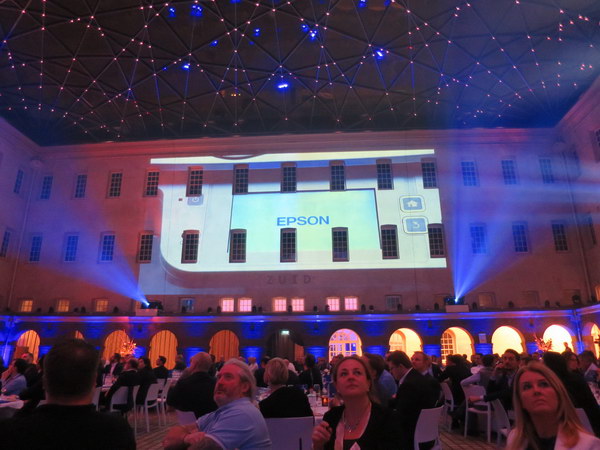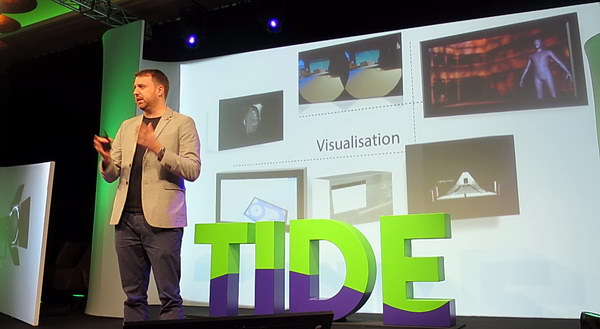On Monday February 4th, as a preliminary to ISE, I attended the TIDE (Technology. Innovation. Design. Experience.) event. This meeting was produced by AVIXA (formerly known as InfoComm International), which is a joint-venture partner with CEDIA in the production of Integrated Systems Europe (ISE).

I was a little disappointed in that, of the 12 speakers, only three of them actually touched on professional audio-video topics, the mainstay of ISE and AVIXA. The other speakers talked about design in more generic terms and applied to topics not of (professional) interest to Display Daily speakers. One speaker, for example discussed, among other things, three dystopian future worlds she had designed for science fiction movies.
Sabine De Schutter, head of the lighting design house Studio De Schutter, talked about “Lighting Design Meets Design Thinking.” While lighting design is a ProAV topic, it bears little relationship to displays so I won’t discuss her talk further.
Ben Moorson, President and creator of Neuroscaping, a division in the Debut Group, spoke on “The Science Behind Better Event Design.” By event design, he meant events such as the extravagant corporate events like the ones used to introduce new products. These are often very expensive for the corporation to put on and can include multiple projectors, LED videowalls, other displays, live music and/or music hosted by a DJ, other entertainment, cocktails, fancy meals, etc. The corporation wants these events to make an impact on attendees and make them memorable. The attendees’ memories should include not just a memory of the spectacular event but also of the message the corporation was trying to impress on the attendees.
 Epson Event at ISE 2017 (Credit: M. Brennesholtz)
Epson Event at ISE 2017 (Credit: M. Brennesholtz)
Moorson says that every event needs to tell a story – the story the event sponsor wants the attendees to hear. According to Moorson, this works best when the event designer can “hack their minds.” He said there is a lot of competition for people’s minds and when you run a corporate event, you don’t want people, for example, to use their phones during the company president’s speech. “Neuroscaping” is the use of data from neural science in the event design to make sure people pay attention when you want them to pay attention. In the past, this as been done mostly by using the event designer’s experience and intuition, sometimes with mixed results.
Neither Moorson’s 15 minute talk nor his website go into much detail about what this neural science is but he did give one specific example. Neural science studies have shown that music with 120 beats/min evokes a special response in people. Faster and people get nervous, slower and they pay less attention. He said detailed timing of the event is also very important. If the event is designed so the president comes out five minutes after a particular moment, he needs to be told not to come early or late. Among other issues Neuroscaping addresses are visual design, color schemes, presentation design and ensuring the event is an immersive experience. Even food design can have an important influence.
Opera is a Special Case
Perhaps the most interesting TIDE talk, from the display point of view, was given by James Simpson, who is Lighting Visualizer for the Royal Opera House in London. Why does the Royal Opera House need a person whose title is “Lighting Visualizer?” The traditional way of lighting an opera or ballet or, for that matter, any theatrical production, is to do a technical rehearsal. For an opera or ballet, this means bringing the often complex sets on stage (a major project in its own right) and spending a day adjusting the lights to satisfy the director. In an opera house, the sets may be changed a couple times a day – rehearse one show in the morning, switch sets to do a matinee of a second show and switch sets again for an evening performance of a third show. The demands on the stage in an opera house put severe limits on the available rehearsal time on stage and the time used for a technical rehearsal might be better spent rehearsing the singers and dancers.
 James Simpson at TIDE discussing lighting visualization and how it couples with 3DOF and 6DOF VR displays. (Credit: M. Brennesholtz)
James Simpson at TIDE discussing lighting visualization and how it couples with 3DOF and 6DOF VR displays. (Credit: M. Brennesholtz)
What a lighting visualizer does is use modern computer imaging techniques to allow as much of this lighting setup as possible to be done on the computer, with only the final touch-up actually done on stage. These techniques start with 3D CAD models of the sets and apply the well-developed techniques of simulated lighting to these set models to see how they would look with lights in various positions, aiming points and colors. These numerical lighting techniques have been used for years, decades in some cases, for things like virtual prototypes of automobiles, computer animation and CGI in movies and video gaming. When I asked Simpson why these techniques hadn’t been applied before to operatic lighting, he told me that the opera is (at least) ten years behind other industries in the application of new technology such as computer visualization.
Simpson has gone beyond just simulating lighting on the computer. He has been using 3DOF HMDs and 360° video to allow the director to actually get inside the opera house. This allows him to see how the sets will look with the chosen lighting design from on-stage or from any point in the audience space. Simpson can add singers and dancers to show how they would look as well. Currently he is working on a 6DOF VR system that will allow the director to actually walk around and look not only in any direction but from multiple vantage points, vantage points not chosen by the lighting designer, the lighting visualizer or anyone else as would be done in a 3DOF system. Did I mention that Simpson is currently working on his PhD in Lighting Visualization?
Lighting visualization coupled with 3DOF or 6DOF VR technology clearly simplifies the production of a new opera and, by extension, any new show. Since it does not limit the director to just a few hours on the stage in a technical rehearsal, the lighting design may actually be improved. These extra hours can then be used for conventional rehearsals, so perhaps the show performance can be improved as well. –Matthew Brennesholtz

